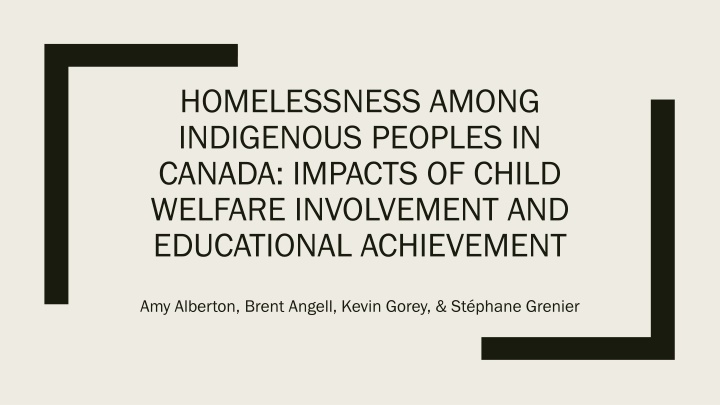
Homelessness Among Indigenous Peoples in Canada
Explore the impacts of child welfare involvement and educational achievement on homelessness among Indigenous peoples in Canada. This study aims to examine key risk and protective factors through critical social theory to promote emancipation and address structural deficits that contribute to homelessness.
Download Presentation

Please find below an Image/Link to download the presentation.
The content on the website is provided AS IS for your information and personal use only. It may not be sold, licensed, or shared on other websites without obtaining consent from the author. If you encounter any issues during the download, it is possible that the publisher has removed the file from their server.
You are allowed to download the files provided on this website for personal or commercial use, subject to the condition that they are used lawfully. All files are the property of their respective owners.
The content on the website is provided AS IS for your information and personal use only. It may not be sold, licensed, or shared on other websites without obtaining consent from the author.
E N D
Presentation Transcript
HOMELESSNESS AMONG INDIGENOUS PEOPLES IN CANADA: IMPACTS OF CHILD WELFARE INVOLVEMENT AND EDUCATIONAL ACHIEVEMENT Amy Alberton, Brent Angell, Kevin Gorey, & St phane Grenier
Introduction Pathways to homelessness are rooted in structural deficits which are multiplicative and intersectional Indigenous peoples experiences of oppression increase risk of homelessness Child welfare identified as contributing to Indigenous peoples homelessness but understudied Generally, greater educational achievement reduces risk of homelessness For Indigenous peoples, evidence is conflicting
Purpose Examine one key risk factor (child welfare) and one key protective factor (educational achievement) related to Indigenous peoples experiences of homelessness Critical social theory with focus on intersectionality to deconstruct and reconstruct experiences with goal being emancipation Test main and interaction effects
Hypotheses 1. Indigenous people are more likely to experience homelessness. 2. People who have been involved in the child welfare system as children are more likely to experience homelessness. 3. People who completed university (college) are less likely to experience homelessness. 4. Of those who were involved in the child welfare system, Indigenous peoples are more disadvantaged than white people. 5. Educational achievement (university degree) is more advantageous for white people than for Indigenous Peoples.
Secondary Data Analysis Canada s General Social Survey Victimization (Cycle 28, 2014) Random Sample: Noninstitutionalized residents, 15 years or older, living in one of the 10 provinces Response rate: 53%
Measures Outcomes: Outcomes: Visible homelessness Hidden homelessness Predictors: Predictors: Ethnicity Child welfare involvement Educational achievement Covariates Covariates Age Gender Childhood abuse Experiences of discrimination Contact with criminal courts
Practical Statistical Analyses Descriptive analyses compared Indigenous and white respondents factors Binary logistic regressions tested main predictive and interacting effects Practical and statistical significance assessed using odds ratios (ORs) and 95% confidence intervals Total analytic sample: n = 24,133
Descriptive Statistics Indigenous Indigenous Percentage Percentage (n = 1,081) (n = 1,081) Non Non- -Indigenous White Indigenous White Percentage Percentage (n = 23,052) (n = 23,052) Ever Experienced Visible Homelessness Ever Experienced Visible Homelessness No Yes Ever Experienced Hidden Homelessness Ever Experienced Hidden Homelessness No Yes Child Welfare System Involvement Child Welfare System Involvement No Yes Highest Level of Education Highest Level of Education Less than high school High school College or trade school University 94.6 5.4 98.4 1.6 81.5 18.5 91.3 8.7 92.9 7.1 98.1 1.9 26.8 30.8 28.9 13.5 16.7 27.6 29.9 25.8
Regression Models Estimating Predictors of Visible Homelessness
Regression Models Estimating Predictors of Hidden Homelessness
Effects of Education on Homelessness within Ethnic Strata
Summary Indigenous identity and involvement in child welfare both strongly associated with visible and hidden homelessness Interaction between Indigenous identity and child welfare was not observed Educational achievement strongly protective for non-Indigenous white, but not at all for Indigenous respondents
Conclusions Indigenous peoples are at far greater risk of becoming homeless than non-Indigenous, white peoples Indigenous peoples more prevalently exposed to involvement in child welfare system (Neo)colonialism and subsequent exposure to structural violence have contributed to increased vulnerabilities among Indigenous peoples in Canada
Practice and Policy Implications Discriminatory child welfare policies must be acknowledged and rectified, focus on holistic and preventative supports Increase awareness of detrimental effects of government policies, overall Canadian Government must redress harms caused by (neo)colonialism Recognize and address poverty, housing, water, sanitation issues, food security, violence, and health and educational inequities
Limitations Data from territories not included Indigenous peoples aggregated into one group, as opposed to being recognized as distinct nations Unable to determine how many homeless episodes were experienced and when they occurred Unable to measure the effect of having children in care on homelessness
Future Research Effects of intersecting sites of structural violence faced by Indigenous peoples, including child welfare involvement, on experiences of homelessness Examine regional differences Qualitatively explore Indigenous peoples past experiences with child welfare services and experiences of homelessness Increase meaningful engagement with First Nations communities in the development of culturally relevant data collection techniques
Co-Investigators Amy Alberton, Amy Alberton, Brent Angell, & Brent Angell, & Kevin Gorey Kevin Gorey School of Social Work, University of Windsor St phane St phane Grenier cole de service social, Universit du Qu bec en Abitibi-T miscamingue Grenier This study was partially supported by Social Sciences and Humanities Research Council (Government of Canada)
Principal Investigator Amy Alberton Amy Alberton For additional information please contact me at: albert3@uwindsor.ca
